|
DODGE DART History
Introduction: The
Dart was Dodge's entry in the growing compact market. Introduced in 1960,
the first generation Dodge Dart was actually just a small fullsize car.
It was "reborn" in 1963 as a true compact. The Dart lineup would continue
to evolve, and included Demon and Swinger models as well as the Dodge Sport
and the mighty Dart GTS.
1960 Dodge Dart
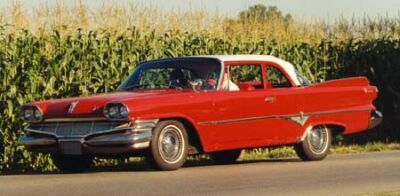 Comments:
The Dodge Dart name first appeared as a radically aerodynamic showcar in
1956. It returned four years later as a new downsized regular production
vehicle. Featuring utilized body construction, and riding on a 118 inch
wheelbase, it was four inches shorter than Dodge's Polara flagship and
thus was Dodge's "compact" fullsize model. The Dart was available as three
models: Seneca, Pioneer, and Phoenix. Engine choices included a 318 cid
V8 with either a two or four barrel carb, or a 361 cid V8 with 310 bhp.
All three models were available with Dodge's D500 performance option which
included the 361 cid V8 with a new ram-induction setup which featured twin
four-barrels on long, individual-runner intake manifolds which had a supercharger
effect. This ram setup was also used on the larger 383 cid V8s used in
Polara models, and a few Ram 383s found their way into the smaller Dart. Comments:
The Dodge Dart name first appeared as a radically aerodynamic showcar in
1956. It returned four years later as a new downsized regular production
vehicle. Featuring utilized body construction, and riding on a 118 inch
wheelbase, it was four inches shorter than Dodge's Polara flagship and
thus was Dodge's "compact" fullsize model. The Dart was available as three
models: Seneca, Pioneer, and Phoenix. Engine choices included a 318 cid
V8 with either a two or four barrel carb, or a 361 cid V8 with 310 bhp.
All three models were available with Dodge's D500 performance option which
included the 361 cid V8 with a new ram-induction setup which featured twin
four-barrels on long, individual-runner intake manifolds which had a supercharger
effect. This ram setup was also used on the larger 383 cid V8s used in
Polara models, and a few Ram 383s found their way into the smaller Dart.
Engines: 318 V8 (2bbl)
230 bhp @ 4400 rpm, 340 lb-ft @ 2400 rpm. 318 V8 (4bbl) 255 bhp @ 4400
rpm, 345 lb-ft @ 2800 rpm. 361 V8 310 bhp @ 4800 rpm, 435 lb-ft @ 2800
rpm.
Performance: 361/310:
0-60 mph in 8 seconds.
1961 Dodge Dart
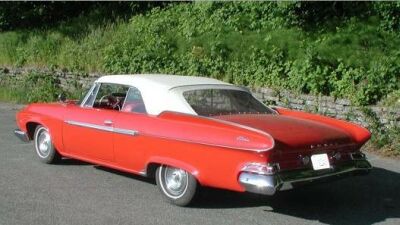 Comments:
The D500 performance option was offered for the last time in 1961, but
it was toned down from the year before. It now included a standard four
barrel carb, or optional ram induction dual carbs (which were standard
the year before). Comments:
The D500 performance option was offered for the last time in 1961, but
it was toned down from the year before. It now included a standard four
barrel carb, or optional ram induction dual carbs (which were standard
the year before).
Production: The 361
engine was slightly detuned for 1961, but that was overshadowed by the
introduction of a new 383 cid V8 option, in either Police or Ram trim.
Engines: 318 V8 (2bbl)
230 bhp @ 4400 rpm, 340 lb-ft @ 2400 rpm. 318 V8 (4bbl) 260 bhp @ 4400
rpm, 345 lb-ft @ 2800 rpm. 361 V8 305 bhp @ 4800 rpm, 395 lb-ft @ 3000
rpm. 383 (Police) V8 325 bhp @ 4600 rpm, 425 lb-ft @ 3200 rpm. 383 (Ram)
V8 330 bhp @ 4800 rpm, 460 lb-ft @ 2800 rpm.
1962 Dodge Dart
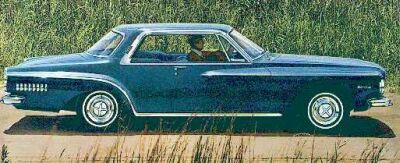 Comments:
1962 saw the peak of Dart performance when Dodge offered its 413 Max Wedge
in all fullsize models, from the bare bones Dart 330 through the top of
the line Polara 500. Most racers preferred the lighter and cheaper Darts.
The 413 Max Wedge was manufactured under precise conditions at Chrysler's
Marine and Industrial Division and was a no-nonsense racing powerplant
not intended for everyday operation. The 413 Max Wedge was offered in two
forms: one with 11:1 compression rated at 410 bhp and the other with 13.5:1
compression rated at 420 bhp. The "Max" refered to the Maximum Performance
label used in factory advertising while the "Wedge" refered to the 413's
Wedge shaped combustion chambers (as opposed to the earlier Hemispherical
designs). Priced at just 4.40, the 410 bhp 413 was affordable and powerful.
The Max Wedge featured free-flowing cast-iron headers, a dual exhaust system
that featured cutouts that could be unbolted for unsilenced, wide open
running. Heavy duty dual valve springs in the heads meant valve seals couldn't
be installed, making the engine a serious oil burner. The Max Wedge also
featured a reinforced block and heads, a forged steel crank, Magnafluxed
forged steel connecting rods, lightweight aluminum pistons, beefed-up valvetrain,
and a deep-sump oil pan. Topping it off were two Carter AFB carbs mounted
diagonally on a cross-ram intake featuring 15 inch individual runners. Comments:
1962 saw the peak of Dart performance when Dodge offered its 413 Max Wedge
in all fullsize models, from the bare bones Dart 330 through the top of
the line Polara 500. Most racers preferred the lighter and cheaper Darts.
The 413 Max Wedge was manufactured under precise conditions at Chrysler's
Marine and Industrial Division and was a no-nonsense racing powerplant
not intended for everyday operation. The 413 Max Wedge was offered in two
forms: one with 11:1 compression rated at 410 bhp and the other with 13.5:1
compression rated at 420 bhp. The "Max" refered to the Maximum Performance
label used in factory advertising while the "Wedge" refered to the 413's
Wedge shaped combustion chambers (as opposed to the earlier Hemispherical
designs). Priced at just 4.40, the 410 bhp 413 was affordable and powerful.
The Max Wedge featured free-flowing cast-iron headers, a dual exhaust system
that featured cutouts that could be unbolted for unsilenced, wide open
running. Heavy duty dual valve springs in the heads meant valve seals couldn't
be installed, making the engine a serious oil burner. The Max Wedge also
featured a reinforced block and heads, a forged steel crank, Magnafluxed
forged steel connecting rods, lightweight aluminum pistons, beefed-up valvetrain,
and a deep-sump oil pan. Topping it off were two Carter AFB carbs mounted
diagonally on a cross-ram intake featuring 15 inch individual runners.
As for styling, the Dodge
Dart was all new for 1962, and sat on a 116 inch wheelbase, three inches
shorter than a normal fullsize vehicle. Worse, Darts were saddled with
some of the ugliest styling ever to be seen on an American vehicle. This
would be the last year for a "fullsize" Dart as the name would be transfered
to a true compact vehicle.
Engines: 318 V8 (2bbl)
230 bhp @ 4400 rpm, 340 lb-ft @ 2400 rpm. 318 V8 (4bbl) 260 bhp @ 4400
rpm, 345 lb-ft @ 2800 rpm. 361 V8 305 bhp @ 4800 rpm, 395 lb-ft @ 3000
rpm. 383 (Police) V8 325 bhp @ 4600 rpm, 425 lb-ft @ 3200 rpm. 383 (Ram)
V8 330 bhp @ 4800 rpm, 460 lb-ft @ 2800 rpm. 413 Max Wedge V8 410 bhp.
413 Max Wedge V8 420 bhp.
Performance: 413/410
bhp: 0-60 in 5.8 seconds, 1/4 mile in 14.4 seconds @ 100 mph.
1963 Dodge Dart
GT
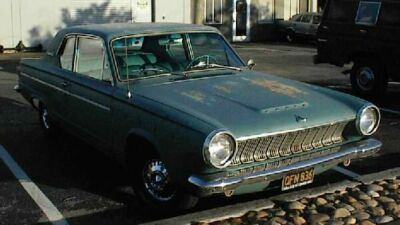 Comments:
The all new Dodge Dart switched to a 111 inch wheelbase and replaced the
Lancer GT as Dodge's sporty compact. The styling penned by Elwood Engle
had a minimum of fussiness. The GT represented the top performing trim
level, although the lack of a V8 was a puzzling omission for a "performance"
car. The Dodge Dart was available as either a hardtop or convertible. Both
had styling that featured prominent headlight bezels that protruded slightly
from the fenders and grille, creating a look that resembled the Chrysler
Turbine car. Styling was generally clean and smooth, with a thick angled
rear pillar. All Darts were covered by a five year, 50,000 mile warranty. Comments:
The all new Dodge Dart switched to a 111 inch wheelbase and replaced the
Lancer GT as Dodge's sporty compact. The styling penned by Elwood Engle
had a minimum of fussiness. The GT represented the top performing trim
level, although the lack of a V8 was a puzzling omission for a "performance"
car. The Dodge Dart was available as either a hardtop or convertible. Both
had styling that featured prominent headlight bezels that protruded slightly
from the fenders and grille, creating a look that resembled the Chrysler
Turbine car. Styling was generally clean and smooth, with a thick angled
rear pillar. All Darts were covered by a five year, 50,000 mile warranty.
Production: I6: 34,227
Engines: 170 I6 101
bhp @ 4400 rpm, 155 lb-ft @ 2400 rpm. 225 I6 145 bhp @ 4000 rpm, 215 lb-ft
@ 2400 rpm.
1964 Dodge Dart
GT
Comments: The Dodge
Dart GT finally got some performance with the addition of Chrysler's fine
273 cid V8 offering 180 bhp. Styling changed slightly with a new convex
grille.
Production: I6: 37,660
V8: 12,170
Engines: 170 I6 101 bhp
@ 4400 rpm, 155 lb-ft @ 2400 rpm. 225 I6 145 bhp @ 4000 rpm, 215 lb-ft
@ 2400 rpm. 273 V8 180 bhp @ 4200 rpm, 260 lb-ft @ 1600 rpm.
Performance: 273/180:
0-60 in 10 seconds.
1965 Dodge Dart
GT
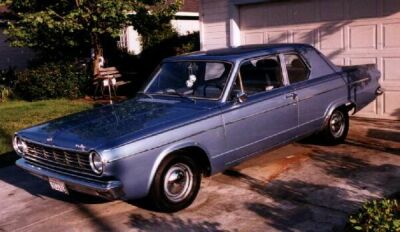 Comments:
1965 saw a further increase in performance as a 235 bhp version of the
273 engine was offered. Comments:
1965 saw a further increase in performance as a 235 bhp version of the
273 engine was offered.
Production: I6: 35,000
V8: 10,000
Engines: 170 I6 101
bhp @ 4400 rpm, 155 lb-ft @ 2400 rpm. 225 I6 145 bhp @ 4000 rpm, 215 lb-ft
@ 2400 rpm. 273 V8 180 bhp @ 4200 rpm, 260 lb-ft @ 1600 rpm. 273 V8 235
bhp @ 5200 rpm, 280 lb-ft @ 4000 rpm.
Performance: 273/225:
0-60 in 8.2 seconds.
1966 Dodge Dart
GT
Comments: 1966 saw
an effective facelift with more squared off lines, a new rectangular grille,
and rectangular headlight bezels.
Production: I6: 20,000
V8: 10,000
Engines: 170 I6 101
bhp @ 4400 rpm, 155 lb-ft @ 2400 rpm. 225 I6 145 bhp @ 4000 rpm, 215 lb-ft
@ 2400 rpm. 273 V8 180 bhp @ 4200 rpm, 260 lb-ft @ 1600 rpm. 273 V8 235
bhp @ 5200 rpm, 280 lb-ft @ 4000 rpm.
1967 Dodge Dart
GT
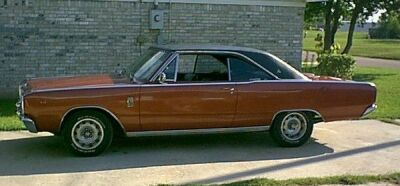
Production: GT V8:
21,600
Engines: 170 I6 101
bhp @ 4400 rpm, 155 lb-ft @ 2400 rpm. 225 I6 145 bhp @ 4000 rpm, 215 lb-ft
@ 2400 rpm. 273 V8 180 bhp @ 4200 rpm, 260 lb-ft @ 1600 rpm. 273 V8 235
bhp @ 5200 rpm, 280 lb-ft @ 4000 rpm.
1968 Dodge Dart
GTS
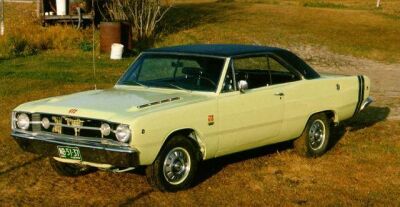 Comments:
Dodge introduced a new GTS trim for its Dodge Dart line to compete against
Chevy's Nova SS. The hot GTS was available with either a standard 340 cid
V8 with 275 bhp or an optional 383 V8 with 300 bhp. Coupled with its light
3,000 pound curb weight, the Dodge Dart GTS did very well on the street
and the track. Unfortunately, the extra weight of the 383 tended to negate
the power advantage of the 383 over the 340. Furthermore, the 340 was rumored
to actually produce over 300 bhp which helps explains the lack of improvement
with the 383 engine. Other technical enhancements included a low-restriction
exhaust system with chrome tips, Rallye suspension, 14x5.5 inch wheel rims
and E70-14 Red Streak tires. A three-on-the-tree manual transmission was
standard, though most GTS models were sold with either a four-speed Hurst
floor shift manual or a competition-type Torque-Flite automatic transmission.
Identifying the GTS were hood power bulges with air vents, body side racing
stripes, special GTS emblems, and simulated mag wheel covers. A rear end
"bumble bee" stripe was a no cost option. Vinyl bucket seats were standard
in the ,611 hardtop and optional in the ,383 convertible. Comments:
Dodge introduced a new GTS trim for its Dodge Dart line to compete against
Chevy's Nova SS. The hot GTS was available with either a standard 340 cid
V8 with 275 bhp or an optional 383 V8 with 300 bhp. Coupled with its light
3,000 pound curb weight, the Dodge Dart GTS did very well on the street
and the track. Unfortunately, the extra weight of the 383 tended to negate
the power advantage of the 383 over the 340. Furthermore, the 340 was rumored
to actually produce over 300 bhp which helps explains the lack of improvement
with the 383 engine. Other technical enhancements included a low-restriction
exhaust system with chrome tips, Rallye suspension, 14x5.5 inch wheel rims
and E70-14 Red Streak tires. A three-on-the-tree manual transmission was
standard, though most GTS models were sold with either a four-speed Hurst
floor shift manual or a competition-type Torque-Flite automatic transmission.
Identifying the GTS were hood power bulges with air vents, body side racing
stripes, special GTS emblems, and simulated mag wheel covers. A rear end
"bumble bee" stripe was a no cost option. Vinyl bucket seats were standard
in the ,611 hardtop and optional in the ,383 convertible.
But another option awaited
those wanting even more performance. For a special few, Dodge shipped 383-spec
Darts (minus Powertrain) along with factory prepped 440 engines to Hurst-Campbell,
Inc., a Michigan after-market company. Hurst-Campbell did the conversion,
Dodge reps inspected it, and the finished cars were forwarded to Grand
Spaulding Auto Sales in Chicago, a performance-oriented dealer. These cars
got vehicle identification numbers, but were not covered by the factory
warranty. With even more weight over the front wheels and no power steering
(it wouldn't fit), the 440 Darts were only good for all out drag racing.
Most modified 440 Darts also received additional performance parts such
as aftermarket headers, ignition kit, hoses, wiring, and air cleaner. Approximately
80 Darts were fitted with the 426 Hemi -- scary.
Production: GTS:
8,745 440: 68
Engines: 340 V8 275
bhp, 340 lb-ft. 383 V8 300 bhp @ 4400 rpm, 400 lb-ft @ 2400 rpm. 440 V8
375 bhp @ 4600 rpm, 480 lb-ft @ 3200 rpm.
Performance: 340/270:
0-60 in 6 seconds, 1/4 mile in 15.2 seconds. 440/375: 0-60 in 5.0 seconds,
1/4 mile in 13.3 seconds @ 107 mph.
1969 Dodge Dart
GTS
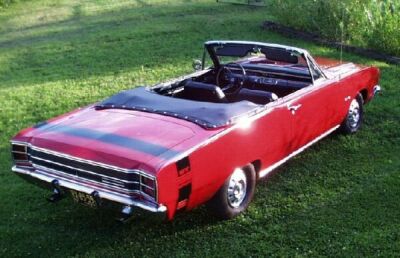 Comments:
The 1969 Dart GTS sported some exterior changes and a more powerful optional
engine. The exterior sported a new black grille with bright horizontal
center bar, and a blacked-out rear body panel. Under the hood, the optional
383 V8 got the full Road Runner/Super Bee treatment and power increased
to 330 bhp. Dodge strengthened the suspension when the 383 was ordered,
increasing the diameter of the front torsion bars and front sway bars.
But the same heavy-duty six-leaf rear springs and E70x14 tires were retained
which made good launches tricky. Transmissions were shared as well, either
a heavy-duty four speed or high-shift Torque-Flite, both with 3.23:1 gears
standard and 3.55:1 or 3.91:1 available with the optional Sure Grip differential.
Also new was a rear "bumble bee" stripe with a separate lower section and
the GT Sport name written on it. The hardtop cost ,226 and the convertible
was ,419. Comments:
The 1969 Dart GTS sported some exterior changes and a more powerful optional
engine. The exterior sported a new black grille with bright horizontal
center bar, and a blacked-out rear body panel. Under the hood, the optional
383 V8 got the full Road Runner/Super Bee treatment and power increased
to 330 bhp. Dodge strengthened the suspension when the 383 was ordered,
increasing the diameter of the front torsion bars and front sway bars.
But the same heavy-duty six-leaf rear springs and E70x14 tires were retained
which made good launches tricky. Transmissions were shared as well, either
a heavy-duty four speed or high-shift Torque-Flite, both with 3.23:1 gears
standard and 3.55:1 or 3.91:1 available with the optional Sure Grip differential.
Also new was a rear "bumble bee" stripe with a separate lower section and
the GT Sport name written on it. The hardtop cost ,226 and the convertible
was ,419.
Another specialty Dart was
the Dart Swinger 340. Standard equipment included the 340 cid V8 with 275
bhp, four speed manual with Hurst shifter, three-spoke steering wheel with
padded hub, Rallye suspension, "Swinger" bumble bee stripes and fat 14
inch wheels and tires. Seven exterior colors and four vinyl colors were
available. All-vinyl upholstery (with full carpeting on four speed cars
only) was included. The Swinger 340 was only available as a two-door hardtop
for ,836. Two axle ratios (3.55:1 and 3.91:1) were available.
Production: GTS:
6,702 Swinger 340: 20,000
Engines: 340 V8 275
bhp @ 5000 rpm, 340 lb-ft @ 3200 rpm. 383 V8 330 bhp @ 5200 rpm, 410 lb-ft
@ 3600 rpm.
1970 Dodge Dart
GTS
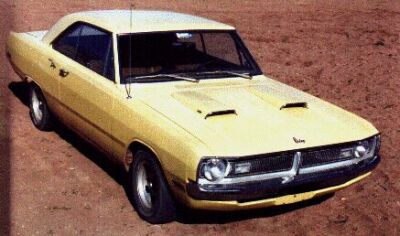 Comments:
The 1970 Dodge Dart lineup returned with Swinger 340 and Dart GTS trim
lines. All Darts had new front and rear styling. The Swinger 340 was available
for ,808 but now included a three-speed manual as standard. Instead of
smaller power vents, the hood now had two long, narrow hood scoops. Front
disc brakes were included. Despite the introduction of the Dodge Challenger,
the Swinger 340 still remained popular, selling 13,785 units. One reason
for its popularity was that insurance companies classified it as a compact
car and thus charged lower premiums than other muscle cars. The Swinger
340 was still fast and could often keep up 340 equiped GTSs. Comments:
The 1970 Dodge Dart lineup returned with Swinger 340 and Dart GTS trim
lines. All Darts had new front and rear styling. The Swinger 340 was available
for ,808 but now included a three-speed manual as standard. Instead of
smaller power vents, the hood now had two long, narrow hood scoops. Front
disc brakes were included. Despite the introduction of the Dodge Challenger,
the Swinger 340 still remained popular, selling 13,785 units. One reason
for its popularity was that insurance companies classified it as a compact
car and thus charged lower premiums than other muscle cars. The Swinger
340 was still fast and could often keep up 340 equiped GTSs.
Production: GTS:
Swinger 340: 13,785
Engines: 340 V8 275
bhp @ 5000 rpm, 340 lb-ft @ 3200 rpm. 383 V8 330 bhp @ 5200 rpm, 410 lb-ft
@ 3600 rpm.
1971 Dodge Demon
340
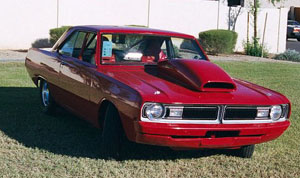 Comments:
1971 saw the addition of the all new Dodge Demon to the Dart lineup. Based
on the Plymouth Duster, it was a pillared two-door fastback with a 108"
wheelbase (three inches shorter than other Darts) and was available in
two trims. The base Demon had the 198 cid I6 standard and minimal equipment,
all for the bargin price of ,343, just more than the Duster. Performance
minded buyers went for the Demon 340, the spiritual successor to the Dodge
Dart GTS. The Demon 340 featured Chrysler's strong 340 small block rated
at 275 bhp. A three speed fully synchronized floor shift was standard,
along with the Rallye instrument cluster, heavy-duty suspension, E70x14
rubber, stripes, and dual exhausts. Options included a dual-scoop matte-black
hood complete with hood pins, rear spoiler, "Tuff" steering wheel, four-speed
manual transmission, TorqueFlite automatic, or upgraded interior. At mid-year,
the Demon Sizzler became available. Based on the base Demon, the Sizzler
added some of the 340's appearance and trim pieces. Both Demon models feature
little cartoon "devil" decals which didn't sit well with some religious
groups, but definitely added to the Demon's flair. Comments:
1971 saw the addition of the all new Dodge Demon to the Dart lineup. Based
on the Plymouth Duster, it was a pillared two-door fastback with a 108"
wheelbase (three inches shorter than other Darts) and was available in
two trims. The base Demon had the 198 cid I6 standard and minimal equipment,
all for the bargin price of ,343, just more than the Duster. Performance
minded buyers went for the Demon 340, the spiritual successor to the Dodge
Dart GTS. The Demon 340 featured Chrysler's strong 340 small block rated
at 275 bhp. A three speed fully synchronized floor shift was standard,
along with the Rallye instrument cluster, heavy-duty suspension, E70x14
rubber, stripes, and dual exhausts. Options included a dual-scoop matte-black
hood complete with hood pins, rear spoiler, "Tuff" steering wheel, four-speed
manual transmission, TorqueFlite automatic, or upgraded interior. At mid-year,
the Demon Sizzler became available. Based on the base Demon, the Sizzler
added some of the 340's appearance and trim pieces. Both Demon models feature
little cartoon "devil" decals which didn't sit well with some religious
groups, but definitely added to the Demon's flair.
Production: Demon
340: 10,098
Engines: 340 V8 275
bhp @ 5000 rpm, 340 lb-ft @ 3200 rpm.
1972 Dodge Demon
340
Comments: The Dodge
Demon continued into 1972 with the only major change being that the 340
V8 was now rated at 240 bhp net as opposed to the previous year's 275 bhp
gross.
Production: Demon
340: 8,700
Engines: 340 V8 240
bhp (net) @ 4800 rpm, 290 lb-ft @ 3600 rpm.
1973 Dodge Dart
Sport
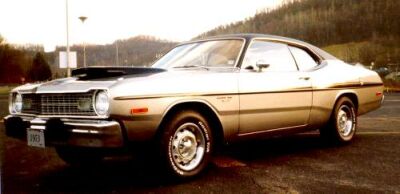
Comments: Bowing
to pressure, Dodge dropped the "Demon" name and renamed its sporty compact
the Dodge Dart Sport. The matte-black hood was dropped, but the other trim
details continued.
Production: 11,315
Engines: 340 V8 240
bhp (net) @ 4800 rpm, 290 lb-ft @ 3600 rpm.
1974 Dodge Dart
Sport
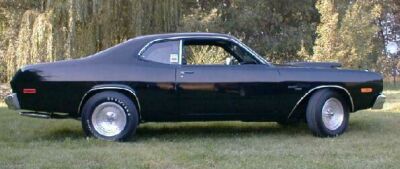
Comments: The 340
engine was replaced by a more emission friendly 360 cid V8 for 1974.
Production: Sport
V8: 23,225 Sport 360: 3,951 Swinger Special V8: 1,944 Special Edition V8:
9,274
Engines: 360 V8 245
bhp (net) @ 4800 rpm, 320 lb-ft @ 3600 rpm.
1975 Dodge Dart
Sport
Comments: The 360
engine was detuned to meet ever tougher emission standards.
Production: Sport
V8: 8,801 Swinger Special V8: 323 Special Edition V8: 6,578
Engines: 360 V8 230
bhp (net) @ 4200 rpm, 300 lb-ft @ 3200 rpm.
1976 Dodge Dart
Sport
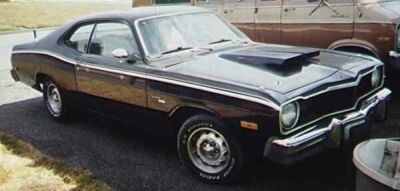 Comments:
The 360 engine was detuned again for 1976, the last year for the Dodge
Dart Sport. Comments:
The 360 engine was detuned again for 1976, the last year for the Dodge
Dart Sport.
Production: Sport
V8: 8,801 Swinger Special V8: 323 Special Edition V8: 6,578
Engines: 360 V8 220
bhp (net) @ 4400 rpm, 280 lb-ft @ 3200 rpm.
|